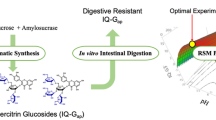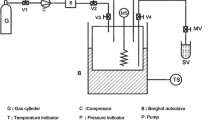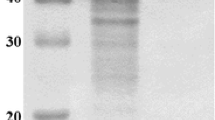Abstract
Response surface methodology (RSM) was employed to optimize amyloglucosidase-catalyzed synthesis of curcumin-bis-α-d-glucoside. A central composite rotatable design (CCRD) was employed involving five variables (enzyme concentration, curcumin concentration, incubation period, buffer concentration and pH) at five levels. A second-order polynomial equation with a R 2 value 0.9 showed good correspondence between experimental and predicted yields. Three-dimensional surface and contour plots generated described the catalytic efficiency of amyloglucosidase under the reaction conditions employed. A maximum conversion of 35% was predicted for curcumin concentrations above 0.55 mmol at 35–60% (w/w d-glucose) amyloglucosidase concentrations. While lower (<35%) amyloglucosidase concentrations converted less, concentrations >60% could be inhibitory to curcumin. Extent of glucosylation was governed by a critical buffer (0.95–1.0 ml of 0.01 M pH 6.0) to enzyme ratio (15–45% w/w d-glucose). Experiments under optimum predicted conditions of 16.9% (w/w d-glucose) amyloglucosidase, 0.33 mmol curcumin, 120 h incubation period, 0.1 mM (1.0 ml of 0.01 M) buffer concentration at pH 7.5 gave a conversion yield of 56.3%. Validation experiments carried out under selected random conditions also showed good correspondence between experimental and predicted yields.




Similar content being viewed by others
References
Busch P, Hensen H, Kahre J, Tesmann H (1994) Agro-Food-Industry Hi-Technol 9:23–28
Hsu FL, Lee YY, Cheng JT (1994) J Nat Prod 57:308–312
Carlton RR, Deans SG, Gray AI, Waterman PG (1991) Chemoecology 2:69–71
Kahne DE, Walker KS (1993) PCT Int. Appl. WO 9311772A1
Konstantinovic S, Predojevic J, Gojkovic S, Ratkovic Z, Mojsilovic B, Pavlovic V (2001) Indian J Chem 40B:1242–1244
Noshita T, Sugiyama T, Kitazumi Y, Oritani T (1995) Biosci Biotechnol Biochem 59:2052–2055
Oku M, Sakai Y (2003) Saibo Kogaku 22:992–993 (Japanese)
Sophie L, Robert G, Pierre K (2004) Chem Commun 5:586–587
Du Y, Wei G, Linhardt RJ (2004) J Org Chem 69:2206–2209
Hergenhahn M, Bertram B, Wiessler M, Sorg BL (2002) German patent application. DE 2337
Aritomi M, Komori T, Kawasaki T (1986) Phytochemistry 25:231–234
Mohri K, Watanable Y, Yoshida Y, Satoh M, Isobe K, Sugimoto N, Tsuda Y (2003) Chem Pharm Bull 51:1268–1272
Vic G, Thomas D, Crout DHG (1997) Enzyme Microb Technol 20:597–603
Lirdprapamongkol K, Svasti J (2000) Biotechnol Lett 22:1889–1894
Yoon SH, Bruce Fulton D, Robyt JF (2004) Carbohydr Res 339:1517–1529
Washino K (1992) Jpn. Kokkyo koho JP 04066098 A2. 1992
Huang KH, Akoh CC (1996) J Food Sci 61:137–141
Shieh CJ, Akok CC, Koehler PE (1995) J Am Oil Chem Soc 72:619–623
Ibanoglu E, Ibanoglu S (2000) Food Chem 70:333–336
Yan Y, Bornscheuer UT, Stadler G, Wahl SL, Reuss R, Schmid RD (2001) J Am Oil Chem Soc 78:147–152
Ismail A, Soultani S, Ghoul M (1998) Biotechnol Prog 14:874–878
Ismail A, Linder M, Ghoul M (1999) Enzyme Microbial Technol 25:208–213
Chahid Z, Montet D, Pina M, Bonnot F, Graille J (1994) Biotechnol Lett 16:795–800
Vijayakumar GR, Manohar B, Divakar S (2005) Eur Food Res Technol 220:272–277
Gomes DCF, Alegrio LV, Leon LL, de Lima MEF (2002) Arzneim-Forsch 52:695–698
Vijayakumar GR, Divakar S (2005) Biotechnol Lett 27:1411–1415
Montogomery DC (1991) Design and analysis of experiments. Wiley, New York, pp 542–547
Chahid Z, Montet D, Pina M, Graille J (1992) Biotechnol Lett 14:281–284
Frandsen TP, Dupont C, Lehmbeck J, Stoffer B, Sierks MR, Honzatko RB, Svensson B (1994) Biochemistry 33:13808–13816
Sierks MR, Ford C, Reilly PJ, Svensson B (1990) Protein Eng 3:193–198
Acknowledgements
Department of Science and Technology, India is gratefully acknowledged for the financial support. GRV acknowledges Council of Scientific and Industrial Research (CSIR), New Delhi, India for providing the Senior Research Fellowship.
Author information
Authors and Affiliations
Corresponding author
Rights and permissions
About this article
Cite this article
Vijayakumar, G.R., Manohar, B. & Divakar, S. Amyloglucosidase-catalysed synthesis of curcumin-bis-α-d-glucoside—a response surface methodological study. Eur Food Res Technol 223, 725–730 (2006). https://doi.org/10.1007/s00217-006-0259-3
Received:
Revised:
Accepted:
Published:
Issue Date:
DOI: https://doi.org/10.1007/s00217-006-0259-3




